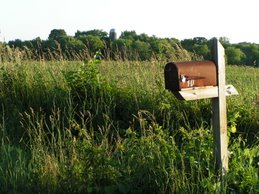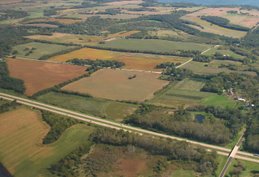Here's an important and timely email (with emphasis added) from Rich Eggleston to the members of the Plan Commission, Common Council, Citizens Advisory Committee on the Comprehensive Plan, and Mayor Tom Clauder.
Monday, 25 Feb 2008
One of the hallmarks of a comprehensive plan that works is flexibility. What we know about the proposed Northeast Neighborhood now, for example, is more than we knew about it two weeks ago, much less two years ago or 20 years ago.
That's why I was miffed by a member of the Plan Commission who suggested recently that I should have brought up concerns about the proposed Northeast Neighborhood in 1985, or, presumably, forever hold my peace.
The need for flexibility in planning is highlighted further by developments in the national economy over which Fitchburg has no control, and immutable demographic reality. You folks are getting older.
A business column in Saturday's New York Times cited research by Arthur C. Nelson, director of Virginia Tech's Metropolitcan Institute, who has predicted that, by 2025, there will be a surplus of 22 million "large-lot homes" (those built on at least one-sixth of an acre) in America.
The column quotes Leinberger as ascribing that surplus to “'the pendulum swinging back toward urban living,' thanks to a set of economic, social, and demographic trends." The result, he says, could be that low-density suburbs “may become what inner cities became in the 1960’s and 1970’s — slums characterized by poverty, crime, and decay.” (article here)
The column built on an article in the latest Atlantic Monthly (here) that said, in part:
"In most metropolitan areas, only 5 to 10 percent of the housing stock is located in walkable urban places...
"Yet recent consumer research by Jonathan Levine of the University of Michigan and Lawrence Frank of the University of British Columbia suggests that roughly one in three homeowners would prefer to live in these types of places. In one study, for instance, Levine and his colleagues asked more than 1,600 mostly suburban residents of the Atlanta and Boston metro areas to hypothetically trade off typical suburban amenities (such as large living spaces) against typical urban ones (like living within walking distance of retail districts).
"All in all, they found that only about a third of the people surveyed solidly preferred traditional suburban lifestyles, featuring large houses and lots of driving. Another third, roughly, had mixed feelings. The final third wanted to live in mixed-use, walkable urban areas—but most had no way to do so at an affordable price. Over time, as urban and faux-urban building continues, that will change.
"Demographic changes in the United States also are working against conventional suburban growth, and are likely to further weaken preferences for car-based suburban living.
"When the Baby Boomers were young, families with children made up more than half of all households; by 2000, they were only a third of households; and by 2025, they will be closer to a quarter. Young people are starting families later than earlier generations did, and having fewer children. The Boomers themselves are becoming empty-nesters, and many have voiced a preference for urban living. By 2025, the U.S. will contain about as many single-person households as families with children."
Topics for comprehensive plans to consider.
Rich Eggleston
Fitchburg
Tuesday, February 26, 2008
Suburbia - The Next Slum?
Posted by
Terry Carpenter
at
11:30 PM
0
comments
![]()
Categories Housing Market, NE Neighborhood Plan, NEN, Transportation
Saturday, February 23, 2008
Greener Homes & Gardens Feb. 27th
Greener Homes & Gardens Expo
Simple steps you can take now, for a cleaner & greener tomorrow
Date: Wednesday, Feb. 27th
Time: Come anytime between 6:30 and 9:00pm
Place: Ancora Coffee -2690 Research Park Dr., just across Lacy Rd. from Fitchburg City Hall
Visit booths, and talk with experts one-on-one, to learn more about:
*How to enhance the beauty of your yard while protecting our lakes, streams, and ground water with rain gardens, rain barrels, & natural yard care
*Simple, practical steps you can take now to reduce water use inside and outside your home
*How to maintain a greener home & cut your energy bill: lighting, conservation, and energy solutions you can use now
*Your solar energy options
*What a CSA farm is, and how you can enjoy healthy, affordable organic foods all year long
* How to sign up for free hands-on nature education opportunities for your child’s classroom or scout troop
*Homeowner grants for native prairie plants at half price
Register to win great green door prizes:
*Sustain Dane rain barrel, installation included
*Water conserving showerheads
*Energy efficient light bulbs
*Nature books for kids and adults
*Nature curriculum materials from National Audubon Society & Cornell Lab of Ornithology
Please call or email Nancy Hylbert for more information:
271-0956, Nancy.Hylbert@Fitchburg.WI.US
Posted by
Terry Carpenter
at
11:10 AM
0
comments
![]()
Categories Green Ideas, Sustainability, Water Resources
Dr. DeWitt's Presentation Posted
As a follow-up to a previous blog, the city has posted Dr. Cal DeWitt's presentation on their website here.
The slide below is my favorite showing the various layers of bedrock deposits in Dane County (top left is north). The two darkest layers are the thickest areas of the Eau Claire formation which comprise the best aquitard separating our upper and lower aquifers. As you can see, much of the county does not benefit from this layer of shale.
Posted by
Terry Carpenter
at
11:00 AM
0
comments
![]()
Categories Cal DeWitt, Plan Comm Meetings, Water Resources



